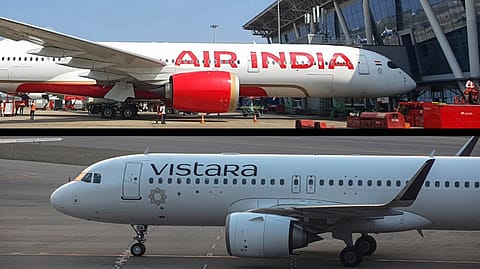Domestic air traffic falls 3% in July
IndiGo, India’s biggest airline, increased its domestic market share to 65.2% in July 2025 from 62% in July 2024.

The number of air passengers carried by domestic airlines declined 2.94% year-on-year to 1.26 crore in July 2025, compared with 1.29 crore in the corresponding month last year, according to data released by aviation regulator DGCA (Directorate General of Civil Aviation).
IndiGo, India’s biggest airline, increased its domestic market share to 65.2% in July 2025 from 62% in July 2024.
Air India Group saw its combined domestic share decline from 28.8% in July 2024 to 26.2% in July 2025. The Tata group consolidated its four airlines into a single group, which operates one full-service carrier, Air India and one low-cost airline, Air India Express.
The drop in Air India’s market share comes following the deadly crash of Air India flight AI-171 in Ahmedabad on June 12, 2025, which killed all but one of the 242 people on board and many others on the ground.
Passenger traffic growth was weighed down by travel hesitancy post the aircraft accident tragedy, according to ICRA. "A prolonged period of monsoons is likely to have affected air travel in July-August 2025," the rating agency said.
Premji Invest-backed Akasa Air increased its domestic market share from 4.7% in July last year to 5.5% in July 2025.
Low-cost carrier SpiceJet saw its domestic market share contract from 3.1% in July 2024 to 2% in July 2025.
Recommended Stories
During January-July 2025, domestic air passenger traffic stood at 9.77 crore as against 9.23 crore during the corresponding period of the previous year, registering an annual growth of 5.9%.
India’s aviation industry has seen consolidation after low-cost carrier GoFirst went bankrupt in 2023. While some players faced liquidity issues, others are operating at a sub-optimal level.
India's two big airlines, IndiGo and Air India, together account for 91.4% market share, making India’s domestic aviation market a virtual duopoly.
Air India Group currently operates a combined fleet of 300 aircraft compared with IndiGo’s fleet of over 400 aircraft.
(INR CR)
In an interview with Fortune India in April, IndiGo CEO Pieter Elbers said the consolidation of India’s domestic aviation industry guarantees stability and continuity, which are important to compete internationally.
“Where we are today is basically a situation which is not unlike some other parts of the world: with two larger airlines and a couple of new relatively young contenders. From a domestic market perspective, that’s probably a more stable setting. With a more stable setting, more continuity is being guaranteed,” Elbers had said.
The IndiGo CEO pointed out that India needs airlines of a certain size and scale to become an aviation hub. “One could argue that it’s good to have 15 different airlines and cut-throat competition, but if we want to build India into a global aviation hub, we should have great airlines,” said Elbers.
Meanwhile, ICRA forecasts a modest increase in domestic air passenger traffic to 17 crore in FY26, reflecting a growth of 4-6% over the previous year, lower than its earlier projections of a 7-10% increase.
ICRA also projects the Indian aviation industry to report a wider net loss of ₹9,500-10,500 crore in FY26 compared to an estimated ₹5,500 crore in FY25. Losses are set to shoot up principally because passenger traffic growth will slow down amid a period of rising aircraft deliveries, it added. "Trade headwinds emanating from US tariffs are set to dampen business sentiments in the coming quarters, bringing more circumspection to travel."
